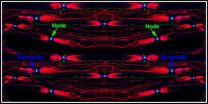(Press-News.org) A recent study confirmed that low socioeconomic status (SES) is associated with higher risk of depressive symptoms in patients with rheumatoid arthritis (RA). Statistically significant differences in race, public versus tertiary-care hospital, disability and medications were found between depressed and non-depressed patients. Study findings are reported in the February issue of Arthritis Care & Research, a journal published by Wiley-Blackwell on behalf of the American College of Rheumatology (ACR).
Roughly 1.3 million Americans are affected by RA—a chronic autoimmune disease that can cause functional limitations and may lead to physical disability in many patients. Prior studies have shown that depression is common, occurring in 13% to 42% of RA patients and is associated with worse outcomes, including greater risk of heart attack, suicide, and death. In the U.S., socioeconomic position as measured by race, gender, age, income, education and health access has significant impact on overall health.
Mary Margaretten, M.D., from the Arthritis Research Group at the University of California, San Francisco (UCSF) and lead study author explained, "We assessed the extent to which low SES influences the relationship between disability and depression in order to better identify those patients at higher risk for depression." Researchers used data obtained from the UCSF RA cohort in which participants were enrolled from an urban county, public hospital that serves the poor and a referral, tertiary-care medical center. The data included 824 visits for 466 patients, 223 from the public hospital and 243 from the tertiary-care clinic.
Analysis showed that 37% of participants had moderate to severe depression, scoring 10 or higher on the Patient Health Questionnaire (PHQ-9). The mean Health Assessment Questionnaire (HAQ) score was 1.2 and the disease activity score (DAS28) was 4, indicating fairly high levels of functional impairment and disease activity, respectively. Researchers also found significant differences between depressed and non-depressed patients related to race, public versus university hospital, functional limitation and disease modifying anti-rheumatic drug (DMARD) treatment. Differences in depression severity were not impacted by gender, age, disease duration, steroid use and dose, or biologic therapy.
Furthermore, the team found that county hospital patients also had significantly higher depression scores (PHQ-9 of 7.3) than patients at the university medical center (PHQ-9 of 5.7). An interaction existed between socioeconomic status and disability such that the association of functional limitation with depression scores was stronger for patients at the public hospital clinic compared to those at the tertiary-care clinic.
Dr. Margaretten concluded, "For the same level of disability, patients with low SES may be more likely to experience depression. Detection and documentation of the differing effects of disability on depression between patients of different socioeconomic status can help rheumatologists improve health outcomes by initiating appropriate and timely treatment for depression."
INFORMATION:
This study is published in Arthritis Care & Research. Media wishing to receive a PDF of this article may contact healthnews@wiley.com.
Full citation: "Socioeconomic Determinants of Disability and Depression in Patients with Rheumatoid Arthritis." M. Margaretten, J. Barton, L. Julian, P. Katz, L. Trupin, C. Tonner, J. Graf, J. Imboden, E. Yelin. Arthritis Care and Research; Published Online: September 7, 2010 (DOI: 10.1002/acr.20345); Print Issue Date: February 2011. http://onlinelibrary.wiley.com/doi/10.1002/acr.20345/abstract
About the Journal
Arthritis Care & Research is an official journal of the American College of Rheumatology (ACR), and the Association of Rheumatology Health Professionals (ARHP), a division of the College. Arthritis Care & Research is a peer-reviewed research publication that publishes both original research and review articles that promote excellence in the clinical practice of rheumatology. Relevant to the care of individuals with arthritis and related disorders, major topics are evidence-based practice studies, clinical problems, practice guidelines, health care economics, health care policy, educational, social, and public health issues, and future trends in rheumatology practice. For details, please visit Arthritis Care & Research.
About Wiley-Blackwell
Wiley-Blackwell is the international scientific, technical, medical, and scholarly publishing business of John Wiley & Sons, with strengths in every major academic and professional field and partnerships with many of the world's leading societies. Wiley-Blackwell publishes nearly 1,500 peer-reviewed journals and 1,500+ new books annually in print and online, as well as databases, major reference works and laboratory protocols. For more information, please visit www.wileyblackwell.com or our new online platform, Wiley Online Library (wileyonlinelibrary.com), one of the world's most extensive multidisciplinary collections of online resources, covering life, health, social and physical sciences, and humanities.
Waterhemp has done it again. University of Illinois researchers just published an article in Pest Management Science confirming that waterhemp is the first weed to evolve resistance to HPPD-inhibiting herbicides.
"A fifth example of resistance in one weed species is overwhelming evidence that resistance to virtually any herbicide used extensively on this species is possible," said Aaron Hager, U of I Extension weed specialist.
Waterhemp is not a weed species that can be adequately managed with one or two different herbicides, Hager said. This troublesome weed requires ...
Scientists found that in 14 independent studies, the yields of two Agave species greatly exceeded the yields of other biofuel feedstocks, such as corn, soybean, sorghum, and wheat. Additionally, even more productive Agave species that have not yet been evaluated exist.
According to bioenergy analyst, Sarah Davis, "We need bioenergy crops that have a low risk of unintended land use change. Biomass from Agave can be harvested as a co-product of tequila production without additional land demands. Also, abandoned Agave plantations in Mexico and Africa that previously supported ...
EAST LANSING, Mich. — It's commonly known, at least among microbiologists, that microbes have an additional option to living or dying — dormancy.
Dormant microbes are less like zombies and more like hibernating bears. What isn't known, however, is how large numbers of dormant microorganisms affect the natural environments when they act as microbial seed banks. In the current issue of Nature Reviews: Microbiology, Jay Lennon, Michigan State University assistant professor of microbiology and molecular genetics, examines the cellular mechanisms that allow microbes to hibernate ...
CHICAGO (January 26) – Scientists at The Rehabilitation Institute of Chicago (RIC), designated the "#1 Rehabilitation Hospital in America" by U.S. News & World Report since 1991, report that, thanks to improvements in technology and data analysis, our understanding of the functional principles that guide the development and operation of the brain could improve drastically in the next few years. The advances could herald a neuroscientific revolution, much as increasing processor speeds paved the way for the computing revolution of the last half century.
In the February, ...
A new target for the prevention of adverse immune responses identified as factors in the development of Alzheimer's disease (AD) has been discovered by researchers at the University of South Florida's Department of Psychiatry and the Center of Excellence for Aging and Brain Repair.
Their findings are published online in the Journal of Neuroscience (http://www.jneurosci.org/).
The CD45 molecule is a receptor on the surface of the brain's microglia cells, cells that support the brain's neurons and also participate in brain immune responses.
Previous studies by the ...
CHAPEL HILL, N.C. -- New research from the University of North Carolina at Chapel Hill School of Medicine describes a key molecular mechanism in nerve fibers that ensures the rapid conductance of nervous system impulses. The findings appear online Jan. 27, 2011 in the journal Neuron.
Our hard-wired nerve fibers or axons rely on an insulating membrane sheath, the myelin, made up of fatty white matter to accelerate the rate of transmission of electrical impulses from the brain to other parts of the body.
Myelin thus acts to prevent electrical current from leaking or prematurely ...
Scientists are reporting discovery of a potential biochemical basis for the apparent cancer-fighting ability of broccoli and its veggie cousins. They found for the first time that certain substances in the vegetables appear to target and block a defective gene associated with cancer. Their report, which could lead to new strategies for preventing and treating cancer, appears in ACS' Journal of Medicinal Chemistry.
Fung-Lung Chung and colleagues showed in previous experiments that substances called isothiocyanates (or ITCs) — found in broccoli, cauliflower, watercress, ...
Scientists are reporting that key chemical components of the 770,000 gallons of oil dispersants applied below the ocean surface in the Deepwater Horizon spill did mix with oil and gas spewing out of the damaged wellhead and remained in the deep ocean for two months or more without degrading. However, it was not possible to determine if the first deep ocean use of oil dispersants worked as planned in breaking up and dissipating the oil. Their study, the first peer-reviewed research published on the fate of oil dispersants added to underwater ocean environments, appears in ...
Scientists are reporting successful application of the technology used in home devices to clean jewelry, dentures, and other items to make anticancer drugs like tamoxifen and paclitaxel dissolve more easily in body fluids, so they can better fight the disease. The process, described in ACS' journal, Langmuir, can make other poorly soluble materials more soluble, and has potential for improving the performance of dyes, paints, rust-proofing agents and other products.
In the report, Yuri M. Lvov and colleagues point out that many drugs, including some of the most powerful ...
Phosphate-free automatic dishwashing detergents — introduced to combat the phosphate-fed algae blooms that foul the nation's lakes and rivers — may be making the fish happy. But they're putting a frown on the faces of some consumers who say the new products leave dishes dirty. That's the topic of the cover story in the current edition of Chemical & Engineering News (C&EN), ACS' weekly newsmagazine.
C&EN Assistant Managing Editor Michael McCoy described how new laws in 16 states require manufacturers to eliminate phosphates from automatic dishwasher detergents sold in ...


